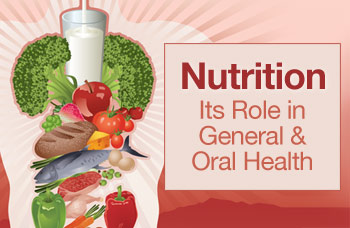Nutrition
Its Role in General & Oral Health

Our previous article on nutrition (“Nutrition & Oral Health”) discussed how dietary factors affect dental and oral health.
In this article, we go a step further and look at how the basics of nutrition, coupled with diet and exercise, affect life-long general and oral health.
The Surgeon General of the United States has stated emphatically that “You can't be healthy without oral health.” And, as our last article explained, you can't have good oral health without good nutrition.
We'll expand on the idea that good nutrition is the key to overall health, both general and oral. In other words, what's good for the whole body is good for your teeth, gums and other oral tissues. We need good nutrition and dietary practices throughout life, for the formation, development and continued health of our oral tissues and structures, as well as those in the rest of the body.
Clarifying the Terms of Nutrition
Food is not only our primary source of nourishment — it's also a profound part of our society, culture and community. What we eat critically impacts not only overall health, but also our risks for several of the leading causes of death like coronary artery disease, stroke, diabetes and some types of cancer.
First, a little clarification: even though the terms “nutrition” and “diet” are often used interchangeably, they aren't synonymous. Nutrition is the end effect of food in the body; diet is an individual's eating habits or food choices. Both play important roles in health.
Foods are the substances we eat that provide the essential components of life — the nutrients.
Nutrients can be classified into six major categories:
- Carbohydrates (sugars, starches, and fibers)
- Proteins (from animal and vegetable sources)
- Fats (preferably from vegetable sources in liquid form)
- Vitamins
- Minerals
- Water
Together, all these types of nutrients perform three basic functions in the body: provide fuel (energy); regulate body processes; and contribute to building body structures.
In fact, very few foods are composed of a single nutrient (refined table sugar, exclusively carbohydrate, is one of those rarities). Most contain a combination of nutrients plus other components. For example, milk contains carbohydrate, protein, fat, water and a variety of vitamins and minerals.
Calorie is another term that is often misunderstood. Calories and nutrients are not the same: calories are a measure of the energy available to the body from foods. Only carbohydrates, proteins, and fats provide calories. One gram of dietary protein provides four calories, one gram of carbohydrate provides four calories, and one gram of fat provides nine calories to the body. So, gram for gram, fats provide about twice the calories of proteins or carbohydrates. Alcohol has seven calories per gram, but is not considered a nutrient!
Nutrients also serve other important functions. For example, proteins provide the building blocks for tissues, while fats provide insulation and cushioning for the body. High fiber carbohydrates provide fiber for intestinal health. Calcium, vitamin D, folic acid and magnesium are needed for maintaining healthy bones.
Some foods are high in nutrients and low in calories, like salad greens. Other foods may be high in calories but low in nutritional value. For example, the only nutrient a soda contains is carbohydrate in the form of sugar. Vitamins and minerals do not provide any calories but they serve other essential functions in the body.
When foods are eaten, the nutrients are absorbed through the small intestine and go through the blood to the liver, and then to the body tissues and structures that need them. Depending upon the nutrient, excesses are either unabsorbed and pass out of the body, or stored in the body. Excess carbohydrates, proteins and fats are ultimately stored as body fats. Excess vitamins A and D are also stored and can be harmful if consumed in greater than recommended amounts. All nutrients are undergoing active metabolism — even “stored” nutrients are constantly being used up and replenished.




